Media | Articles
9 roadside repairs that tested my DIY limits
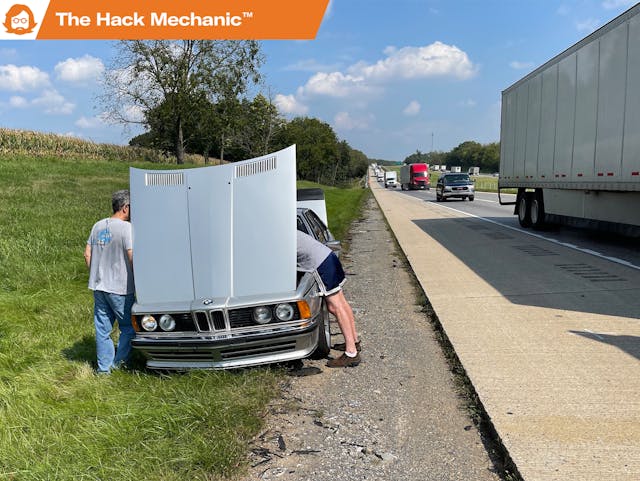
If you’re tooling around close to home in a vintage car, breakdowns aren’t really that big of a deal. Your Hagerty or AAA coverage will probably tow the car home for free or close enough, and you can fix it there. But if you’re road-tripping a car, breakdowns are a much bigger deal. Even if the cause is something you think you can fix, you really don’t want to be in a situation where you need to be under a car when trucks are whipping past only 10 feet away. Anything you know is wrong with a car that is likely to put it in the breakdown lane really should be fixed before a trip.
That having been said, breakdowns happen, and when the cause is obvious and easily addressable, roadside repairs get made. To be clear, whenever possible, don’t literally repair it roadside—if you’re on the highway, limp the car to an exit and find a parking lot instead. Cooling system and oil pressure issues, however, carry a special urgency, as failure to act immediately can result in a cracked head or a lunched engine.
When a roadside repair is ingenious or difficult, it turns into the stuff of legend. I’ve heard stories about broken fan belts in Volkswagens being addressed (or undressed) by convincing a female companion to surrender her panty hose and fashioning a belt out of it (likely a relationship-cementing or a relationship-ending event). One South African friend told me a story about engine failure in a remote area and a weeks-long process of walking miles and hitchhiking while carrying a cylinder head to and from a machine shop. And I witnessed two good friends of mine replace a BMW 2002’s blown head gasket in a hotel parking lot in under an hour and a half.
Now, nothing I’ve done approaches these feats. But after 47 years of wrenching, these are the roadside repairs that stand out above the usual wiring-up of hanging exhausts, reseated distributor caps, “your alternator won’t charge without excitation current from the battery warning light” fixes, and getting a car to start by tapping on the positive battery clamp, the starter, or the electric fuel pump, then going “Ayyyy” like Fonzie.
1. Water pump failure in the Triumph GT6+
In high school, I had been a bicycle guy—riding bikes, fixing bikes, pulling bikes out of the trash and rejuvenating them with parts from other bikes. The summer before college, I was planning on cycling cross-country, which scared the bejesus out of my mother. She blatantly bribed me by offering to buy me a car. I took the bribe and bought the then-six-year-old 1970 Triumph GT6+, easily the worst car I’ve ever owned.
The first of many failures occurred when the car overheated in the hill country north of Amherst, Massachusetts. I limped it to that night’s destination, a friend’s father’s house. I didn’t know much about cars, but knowing bikes, to me the car was just another mechanical system. I could see that the part where water was streaming out had a pulley and a belt on it, and deduced that it was the water pump. I made a few phone calls, found a shop in nearby Hadley that had one, hitchhiked there, and bought it … and the gasket … and the sealant … and the antifreeze.
My friend’s father had enough tools for me to do the job. I had my first taste of the joy of getting myself out of trouble. There were other more devastating mechanical failures to come, and of course the requisite Lucas electrical system problems, but if anything is ground zero for me becoming The Hack Mechanic, it was this.

2. Points closing up in the VW Bus
In early January 1982, my then-girlfriend and now-wife Maire Anne and I moved from Boston down to Austin, Texas, in her rotted 1971 VW Bus with no heat. After surviving an ice storm in Pennsylvania, we finally made it to warmer climes, but somewhere in Arkansas, the bus lost power and sputtered into the breakdown lane. As the de-facto mechanic of my girlfriend’s car, I’d read John Muir’s classic How to Keep Your Volkswagen Alive: A Manual of Step-By-Step Procedures for the Compleat Idiot cover-to-cover. This was my first “it’s almost always the points” experience—due to pitting on the point faces and wear in the little nylon block that runs on the distributor shaft, the point gap had closed up until it no longer triggered the coil. I pulled the points, filed them, did the trick of gapping them with a matchbook cover (which is about the 0.016-inch needed), and voila. I think this is why Maire Anne later married me.
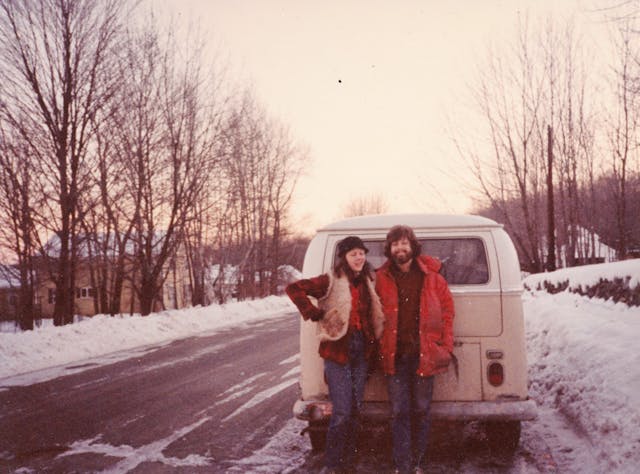
3. Fixing the 2800CS in the middle of a busy intersection
In 1988, I looked at two BMW 2800CS E9 coupes from a salvage yard north of Boston. One was a wrecked picked-over parts car, but the other surprised me by being rusty but whole, and starting and running. I bought them and decided to drive the good one home, use it as a winter beater, and part it out the following spring (I had two other E9 coupes). A few days later, Maire Anne drove me over to the junkyard in our 1983 Volvo 245GLT wagon. I slapped a plate from my daily driver on the 2800CS, jump-started its doornail-dead battery with the Volvo (incredibly foolish—I should’ve brought a fully-charged battery from another car instead), verified that no fluid was gushing out from under the engine compartment, and off we went. Through traffic. At rush hour. Ah, youth. When I was trying to get through the very busy intersection of Rt. 28 and Memorial Drive, I didn’t feed enough gas coming off the clutch, and the car stalled. Since the battery was dead, there was no re-starting it.
So, there I am in the middle of a city intersection at rush hour in a dead, rusty, uninsured, unregistered old car that looked like Beatrix Kiddo in Kill Bill II when she escaped from being buried alive. With it nearly impossible to position the Volvo nose-to-nose to the 2800CS to jump it, I motioned Maire Anne to drive the Volvo to the curb. I ran over, popped open the Volvo’s hood, yanked out its battery (also foolish, as doing so on a running car risks blowing the diodes in the alternator, but necessary), wrapped the positive battery cable in a glove so it wouldn’t short to ground, said to Maire Anne, “Whatever you do, don’t stall,” ran into the intersection with the Volvo’s battery, threw it in the 2800, started it, and drove home. Certainly not one of my smarter moves, but a good story.

4. Reconnecting the half-axle on the Vanagon
Before I began my serial relationship with Suburbans, I had Vanagons. They were weird cars but cavernous inside. I think I went through half a dozen of them before we finally bought the Toyota Previa, which also was weird but was more reliable. When I bought the first Vanagon, the clutch was slipping badly. I dropped the engine (very similar to the old VW busses—support it on blocks, unbolt the bumper, unbolt the engine, roll the bus forward) and replaced the clutch. A few days later, my sister needed to borrow the Vanagon to pick up a piece of furniture. That afternoon, I got a call from her from a payphone (this was pre-cell-phone days) saying that the Vanagon began making a loud rumble, then very loud whacking sounds came from the back.
She and the car were a few miles away. I shot over there with my tools and found that one end of one of the half-axles was flopping in the breeze. Apparently I hadn’t torqued down the ring of Allen-head bolts holding it to the flange on the transaxle. I crawled under the car, tightened things up, and sent my sister on her way. Some 35 years later, she will still sometimes needle me, “Remember when the axle fell off the Vanagon you leant me?” I, of course, will correct her and say, “It wasn’t ‘the axle.’ It was one of the half-axles. And it didn’t fall off—one end just got loose. And I came immediately and tightened it back up, didn’t I?” The funny thing is that, looking back on it, I can’t remember why I had to detach the half-axles at all. Maybe there was some reason why I needed to pull the engine and transaxle together.
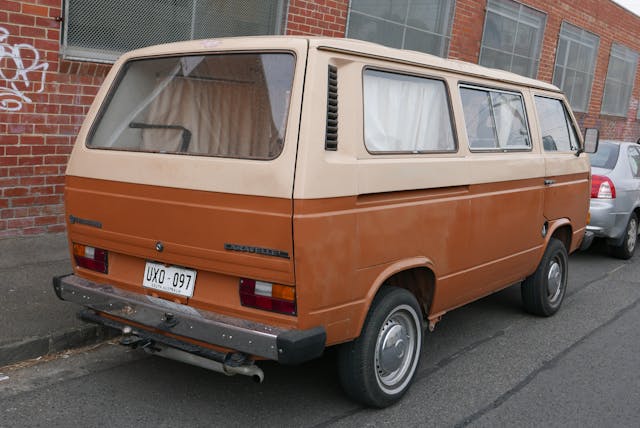
5. Unadjustable fan belt on a 635CSi
I had a 1985 BMW 635CSi that had been gifted to me by my son’s girlfriend’s father. He was mainly a Mercedes guy, and his Mercedes mechanic couldn’t figure out why the 635 wouldn’t start. It turned out to simply be a bad distributor cap. That, an air flow meter, and new injectors got the car running well, but it was by no means well-sorted, and the young man who bought it from me surprised by saying that he wanted to join my convoy on the 2000-mile round trip to The Vintage in Asheville. I warned him that this was risky. He said that he understood that I wasn’t his traveling mechanic, but I couldn’t help but feel a sense of responsibility for both him and the car. Sure enough, on the drive down, the car’s temperature began creeping up and eventually headed for the red zone.
We took the next exit. I found that the belt was slipping even though there was no audible squealing, and the slippage resulted in the water pump not continuously spinning. I tried to adjust the belt, but the bolt in the adjuster track was at the end of the slot, indicating either that the belt was wrong to begin with or had stretched. I was afraid that, if he drove the car hot, he’d crack the head, and I was about to search for the nearest auto parts store when I noticed that next door to the convenience store we’d pulled into was a machine shop where we were able to borrow a round file. I removed the bracket, and Jordan (“the kid”) did the hard work extending the adjustment slot (hey, it was his car). It worked like a charm. We later found a shorter belt, but never needed to install it.
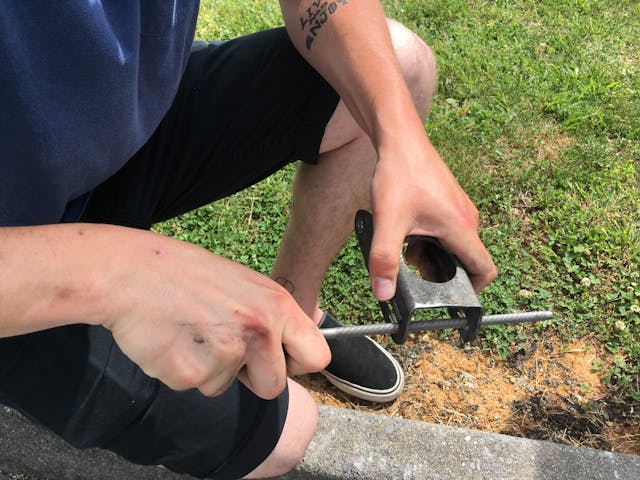
6. Cracked fan on a Euro 635CSi
I was driving my ’79 Euro 635CSi on the return trip from The Vintage—the same trip where I fixed the kid’s unadjustable fan belt. During a rest stop, I opened up the hood to check the oil and was stunned to see that two blades had flown off the belt-driven cooling fan. The 635CSi’s six-cylinder M30 engine was used in BMWs from 1968 through ’95, but it went through three different water pump, fan clutch, and fan configurations, and new parts are no longer available for anything other than the final configuration. I put out the call to friends on Facebook, but unless someone had an old fan, I’d need to replace not just the fan but also update the water pump, the fan clutch, and the pulley.
I removed the fan lest it lose another blade and slice open a coolant hose. This required removing the radiator, which in turn required dumping the coolant. Fortunately I was able to send one of my road trip companions to a nearby Autozone for a catch basin and a few gallons of antifreeze. Driving without a belt-driven cooling fan is usually fine when cruising at highway speeds, but if there’s not enough air flow over the radiator at low speeds or in traffic, it can send temperatures into the red and crack the head. I made a quick wiring mod that allowed me to run the electric pusher fan that’s in front of the A/C condenser without turning on the A/C, and let the car idle in the parking lot to test it. The temperature seemed to top out at about 3/4 of the way up the gauge, so I felt pretty good about making a run for it.
In the meantime, a friend about 150 miles north and on the way home messaged me that he had every part to do the full water pump/clutch/fan/pulley upgrade. We made it to his garage without incident, where I installed the newer-style cooling components. The car’s cooling system was fine until…

7. Leaky heater hose on the same car
A few years later, again on the way to The Vintage and driving the same ’79 Euro 635CSi, I had another cooling system issue. The irony was that, having experienced cooling system issues the last time I road-tripped the car, I wanted to be certain everything was copasetic, so I inspected the cooling system. I found a heater hose that was obviously ballooned and soft. The hose was listed as no longer available from BMW, but I found one as new old stock (NOS) on eBay. I clicked and bought it, but wasn’t certain it would arrive in time, so I hunted around on my parts shelves for a replacement. I found what appeared to be a perfectly good used heater hose. It was clearly better than the ballooned one in the car, so I installed it.
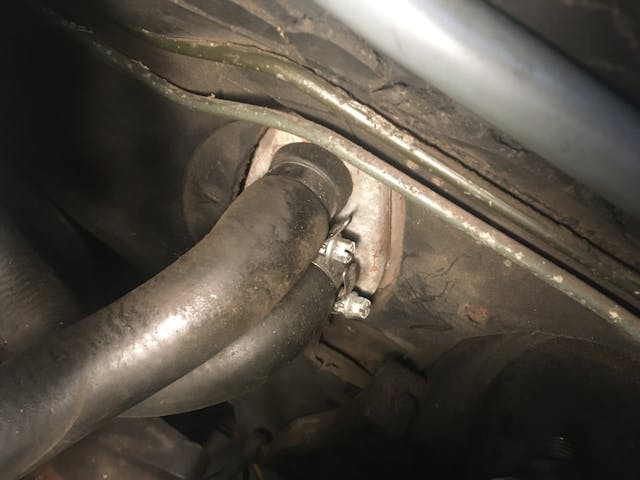
When the NOS hose arrived, I tossed it in the trunk as a spare. On the way to The Vintage, the car’s temp crept up, but did so slowly enough that I thought it was just due to the outside temperature increasing as we headed south, combined with the car rolling up and down the Blue Ridge mountains, but when it tickled the red, I pulled over. I-81 is one of the most heavily trucked routes in the country, so I made it a point to get the car as far off the breakdown lane as I could. Sure enough, the engine was peeing coolant … out the hose I’d just replaced.
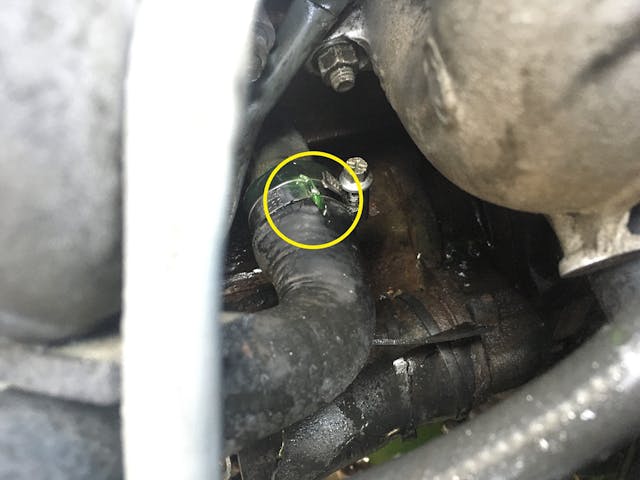
Fortunately, I had the NOS hose in the trunk. While I was waiting for the engine to cool down, I sent my travel companions for antifreeze, at which we all had a serious déjà vu, as the same thing happened with the car and the same people three years prior. It was yet another reminder how much easier these things are when you’re not trying to act like a lone wolf.

8. High beam stalk disintegrates on the Merritt Parkway
The Merritt Parkway is a windy two-lane road north of New York City with a lot of elevation changes. When I was younger, I used to love the Merritt for that reason, but in my dotage I find it stressful due to the 85-mph traffic, the sudden squeezing of two lanes down to one due to construction, the lack of illumination at night, and the repeated experience of coming over one of the rises and having to jam on the brakes due to the sudden sea of red lights. As such, I usually avoid it, but sometimes I’ll just do whatever Waze says, and if it takes me via the Merritt, so be it. Such was the case on one of my trips to The Vintage in a 2002tii.
It was night. Traffic was light to moderate, so there was a lot of toggling the stalk between low and high beams. During one such flick, the stalk fell apart in my hand. What’s the big deal, you might say? Did it fail in the low or high beam position? That was the problem. Neither—my headlights went completely out. With the Merritt Parkway’s lack of lighting, I was abruptly plunged into darkness. I slowed down while fumbling with the stalk to see if I could restore lighting. Fortunately I found one fragile position where the lights came back on, but they went out if I deviated in the slightest. I drove very carefully that way—one hand on the wheel, the other on the stalk—until I came to a rest area. On road trips, I always pack a roll of wire, a variety of connectors, and a crimping tool, so I had no question that, if necessary, I would wire the lights directly to the fuse box, but I thought that I’d first try fixing the stalk. I took the upper and lower panels off the steering column to expose the stalks and found that the potted metal tabs holding the Bakelite back of the stalk in place had broken off.
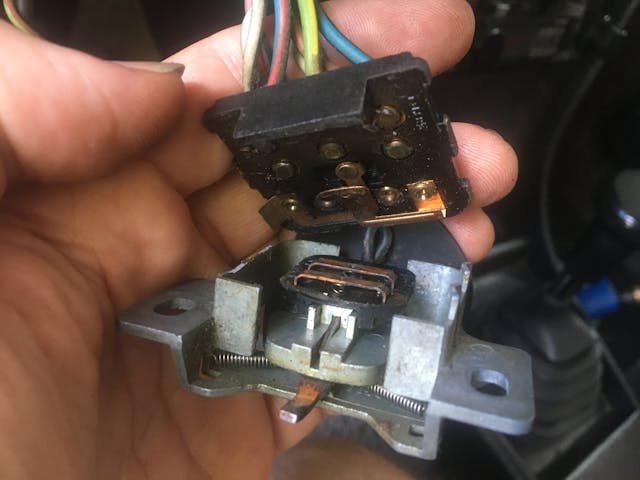
I carefully put the stalk back together, held it together with zip ties, re-attached it, and tested it. It held. For the rest of the trip, I flicked the stalk very carefully lest it fall apart again, but it’s now eight years later, and those zip ties are still in place.
9. J-B Welding a cracked head
I’d say that I’m saving the best for last, but I already wrote about the time that I J-B Welded a cracked cylinder head in a lot of detail here. It almost doesn’t count as a roadside repair, as it didn’t technically fail on the road, and as it certainly wasn’t fixed roadside—I was in a first-class repair shop with the advice of a seen-it-all mechanic—but it was still enormously satisfying to stop the dripping of oil out a crack at the top of the head onto the exhaust manifold using J-B Weld and be driving home a few hours later.

How about you folks? What was your favorite roadside repair? Wipers pulled back and forth with rope? Throttle controlled with a hand-yanked cable? Tell me what you’ve got.
***
Rob’s latest book, The Best Of The Hack Mechanic™: 35 years of hacks, kluges, and assorted automotive mayhem is available on Amazon here. His other seven books are available here on Amazon, or you can order personally-inscribed copies from Rob’s website, www.robsiegel.com.
Check out the Hagerty Media homepage so you don’t miss a single story, or better yet, bookmark it. To get our best stories delivered right to your inbox, subscribe to our newsletters.
Marketplace
Buy and sell classics with confidence













Careful diagnosis of any car trouble is worth tons of cure. In 1972 when my former wife and I had a ‘66 Thunderbird, she called late on a Friday to say the car had overheated and she had coasted into a gas station just off the freeway. The mechanic on duty said the Bird had blown a head gasket and they couldn’t fix it until Monday. By the time I got there to pick her up in my beater car, an all but indestructible ‘63 Belvedere, it was dark and the Bird was in one of the closed-up bays and only a gas jockey remained on duty.
I came back the next morning with the wife and my toolbox and the biggest flashlight I owned. “You need a head gasket, man,” the attendant said. I told him to open up the bay so I could see my car with some daylight. I turned on the big 390 and proceeded to take a look. The gas jockey pointed to where there was coolant spilling from the lowest point of a drooping heater hose. With the flashlight, I traced the leak back up to the firewall where the the hose went through the firewall to the heater.
I backed the car out onto lot, bought a couple of heater hoses and clamps, and we were on our way.
On a road trip from San Francisco to Lake Tahoe area in the late1980s, my ‘75 Blazer overheated in the Central Valley. It was Labor Day weekend, 95 degrees, and there were no mechanics on duty at the nearest gas station. I let the 350 cool down, removed the thermostat, bought some gasket material and sealer and closed it up, sans thermostat. The car ran cool through the mountains, and I drove another 100K miles with out a thermostat.
When I was in college in the mid 70’s I drove a 67 Chevy Impala. A boat with a reliable 283 cid. I lived in Chicago and anyone who has lived through a Chicago winter will tell you it can get very very cold. This was one of those cold days when the water pump decided it was time to blow its seal. The temp. was below zero and the car was parked outside my Apt. building. I called around to see what it would cost me to have it replaced and since I was a struggling college student it was out of my price range. I called the local parts store and found the water pump which was actually rather inexpensive so I decided to replace the pump myself. The procedure went something like this, I would remove a bolt go back inside get warm go out and remove a bolt, go back inside warm up again, and repeat. Needless to say, it took me a good part of the day to replace that pump which was still working fine when I sold the car.
Great stories and writing from a Great Writer! Thanks, Mr. Siegel
Ahhh, I long for the days when a feller could own four E9s.
Summer 1980, I-30W approaching Sulphur Springs, Texas traveling west. About 12:30 PM as we leave the rest area we hear the lifters ticking… Robert glances down to the oil pressure gauge and it’s on 0 PSI. He pulls off the interstate on the shoulder near an overpass. Recently rebuilt engine 351W; checked oil gauge line, oil level, good; pulled distributor to check oil pump drive shaft, good. Hmm… Reluctantly he drains some of the oil onto the shoulder, loosen the motor mount bolts, jacks the engine up and unbolts the oil pan. Inspecting the pickup tube and pump he notices a gap where the tube bolts to the pump. The nut has backed off the stud, I hand him a wrench and as he tightens it the mounting ear cracks off and falls into the pan. Now we know why the sudden loss of oil pressure and we’re greatful it wasn’t worse. As we begin feeling alone, and a bit worried now; looking at the miles of interstate highway and nothing in sight. Just then a chevy truck pulls up behind us and stops. We couldn’t have been more blessed that day. This stranger walks up and asks if he can be of assistance. We tell him the situation and have little hope at this point, we’re about 100 miles from D/FW. He smiles and says his father owns an auto-parts store down the road about 30 miles. It’s Sunday and closed, no biggie. I don’t even recall the young mans name but he went and brought us oil, a new oil pump and necessary gaskets, etc. My oldest brother changed the oil pump on the side of I-30W that Sunday afternoon with the blessing of a stranger who stopped to check on us. We paid him for the goods and made our way to D/FW about 4 hours later than planned with a great story. To this day I don’t know that man but I do know he is a good one. It’s one of those memories without understanding, just friendship and faith in our fellow man.
Being a car guy and working at many dealerships in the past I “repaired’ many autos in the parking lot of various dealerships. Foreign and domestic for you “furrin” car haters. Chevy and BMW ….I worked at all of them. Owning many English cars I have been visited by Lucosi the evil prince of negative electron flow that brought fourth fire to just a “little smoke”. My favorite of all time was the day the rear axle “left” the housing on the side of the road in our family “spare” vehicle 1967 1/2 Volvo 144. My sisters called from a pay phone and said the “tire is coming off and its making noise”. My father and I loaded up our Mopar van and with basic tools managed to get the axle back in the tube, find all the bolts/nuts that it shed and drive it back the 30 plus miles to my parents home. Mind you this was in definite gang territory and my sisters said their social skills saved their butts ! I could list several others but my grandfathers 39 Dodge stake truck roadside generator repair in the dark with tin foil, road debris, and case sod buster -his Teutonic wisdom is memorable 60 plus years later. He was an amazing man !
My first car was also a Triumph GT6 and also easily the worst car I ever owned, but the one I loved the most. I sold it 47 years ago and I still regret letting it go. I had to perform many roadside repairs (and learned so much doing so) but the most interesting story wasn’t exactly a roadside repair. It had wire wheels that were held on the splined hub with one large nut. The splines on the hub were too small and made of “mush” metal. Once after braking hard, the splines let go which unscrewed the large nuts and the wheels came loose. After tightening the wheels, I could drive the car, but couldn’t use the brakes. My dad came with his Ford pick-up truck and a chain. We put the truck behind the car with the chain in between. I drove the car and would hold up my hand when I wanted to stop. My dad would then step on the brakes in the truck. It must have looked really silly to see a tiny car apparently towing a full sized pick-up truck!
Three-way tie. Easiest? Talking about how I could drive my car across the country, right as I stopped moving and the engine stopped accelerating. Managed to rig the throttle linkage bushing to the throttle enough to make it home.
Second? Same car, coolant pouring out of the cracked radiator plastic at a seam. A knife, some JB weld, and a ride back home and back to work the next day, I drove it that way for 7 years.
Worst? Having the alternator go out in my old jeep, and coasting into an auto store parking lot in darkness, then changing the alternator out with whatever tools I could scrounge up/borrow.
In my 20s my friends and I were into old police cars (90’s boxbody Crown Vics). One of them had a perpetual issue with the starter. I had to replace it enough times that I had the ratchet and two sockets I needed in the glove box and could change it in the dark by feel. I forget what the problem ultimately was but he finally got it sorted out.
Back in the late 70s, upon leaving Myrtle Beach after a week of vacation, my friend quickly returned in his ‘65 Mustang and said that he had no oil pressure. A short run of the engine confirmed this, as there was noticeable valve train noise. Since we both were due back at work the next day, we dug into the repair. Of course, neither of us had ever done anything this complex before, and we had minimal tools with us. After parking the car with the front end on a parking curb for clearance, we removed the tie rod, the oil pan, and the oil pump. Sure enough, the pump was frozen, and its drive shaft was twisted apart. Then the fun began. We could only find one half of the drive shaft. Thinking that maybe it was tangled up somewhere among the crankshaft and connecting rods, we made a thorough search of the engine internals by bumping the starter to rotate the crankshaft. No joy. After puzzling over this a bit, we came to the conclusion that the missing shaft piece must have gone out through the oil pan bucket. Both of us would have taken serious bets that this was not possible. A quick feel around the bottom of our oil drain bucket confirmed that’s where it ended up. With all loose and broken parts accounted for, we proceeded to put the new pump in and reassemble everything. The Mustang was back on the road after a few hours, and we were both back at work the next day. And the Mustang’s 289 continued to run just fine for many years after. Success in a motel parking lot!
Nice to read all these stories ! .
I’m a Mechanic by trade and have done more roadside repairs than I can remember, some on my vehicles, most on others, _especially_ my idiot elder brother who regularly ignores my pre road trip comments so I’m replacing fuel pumps, hoses, thermostats and God knows what all else 2,000 + miles from home .
So often some nice person will come by and ask if I need help, or some $ or if I’ve eaten recently……
I get so embarrassed I want to throttle my big brother…..
Much of my practical experience with this comes from being a farm, junkyard, gas station, used car lot, salvage – reconstruct Mechanic, I get to see 1/2arse repairs and bodges others have done before me so I learn whilst I’m fixing things .
-Nate
They are all foreign cars that broke down. ‘Nuff said.
I remembered I was at a drive-in movie theater with my date . My “65” Ford LTD wouldn’t start. So as my date watched the movie, I rebuilt the whole motor with just pilers, screwdriver, and crescent wrench. LOL !